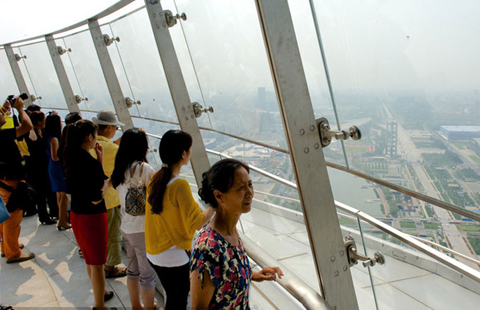Designers complete work on unmanned spacecraft
Updated: 2014-09-05 08:39
By Zhao Lei(China Daily)
|
||||||||
China has finished designing its first cargo spacecraft, which will ferry supplies and fuel to the nation's future multi-cabin, manned space station.
The design and technology of the unmanned Tianzhou cargo spacecraft have been approved by an expert panel from China Aerospace Science and Technology Corp and the China Academy of Space Technology, company sources said.
Chinese scientists and engineers will soon begin building a production-model Tianzhou.
The spacecraft's development began in July 2012 and is based on the design of the Tiangong-1, China's space laboratory, and Shenzhou manned spacecrafts. Its major tasks will be to transport supplies to and refuel the manned space station.
It will also retrieve waste from the station and the waste will burn up as the spacecraft re-enters Earth's atmosphere, the company said in a statement on the China Manned Space Engineering Project website.
Tianzhou will weigh 13 metric tons, and its cargo capacity will be about 6 tons, Zha Xuelei, deputy chief designer of the Tianzhou system, told China Science Daily.
Tianzhou's first launch will take place around 2016 to serve the Tiangong-2 space laboratory, which is planned to be put into orbit before the end of 2015, Zhou Jianping, chief designer of the nation's manned space program, told Xinhua News Agency.
It will be launched atop the Long March 7 rocket, which is under development, from the newly built Wenchang Launch Center in Hainan province.
A test launch of the Long March 7 and Tianzhou will be conducted later this year, the company said in April.
A cargo transportation system that supplies materials and fuel is key to China building its own space station, which the government plans to be operational around 2020, according to Chinese scientists involved in the project.
Xu Jing, editor of Space International magazine, said: "The technologies required for an unmanned cargo spacecraft are not as sophisticated as those used on manned spacecraft because they do not need life-support systems and more complicated configurations."
She said the United States had used space shuttles to transport astronauts and supplies to the International Space Station but finally decided to decommission all of its shuttles because of the high maintenance costs and lower reliability compared with expendable cargo vehicles.
"To my knowledge, most of the technologies used on the Tianzhou have been tested on previous Chinese spacecraft and are thus very reliable," she said.
The world's first cargo spacecraft, Progress 7K-TG, was developed and launched by the former Soviet Union in 1978.
By the end of 2013, 155 cargo vehicles had been sent to deliver supplies to space stations. Currently, five types are in service, including the European Automated Transfer Vehicle and the Japanese H-II Transfer Vehicle.
zhaolei@chinadaily.com.cn
(China Daily 09/05/2014 page3)

 Snoopy celebrates 65th anniversary in Shanghai
Snoopy celebrates 65th anniversary in Shanghai
 Shanghai Library joins global database
Shanghai Library joins global database
 Lives risked daily in the shadow of active volcanoes
Lives risked daily in the shadow of active volcanoes
 History hailed
History hailed
 Chinese TV dating comes to Houston
Chinese TV dating comes to Houston
 China-made electric cars heading to US
China-made electric cars heading to US
 Three Gorges Dam discharges flood water
Three Gorges Dam discharges flood water
 Moon Festival not just for Chinese
Moon Festival not just for Chinese
Most Viewed
Editor's Picks

|

|

|

|

|

|
Today's Top News
Wal-Mart to build shopping center in China
US to pave way for Obama's visit
Wal-Mart seeks China growth
Firms fret over monopoly probes
Chinese TV dating comes to Houston
Joint forces to curb illegal abortions
Can HK afford a credit rating cut?
Hotline to help out Chinese overseas
US Weekly

|

|







